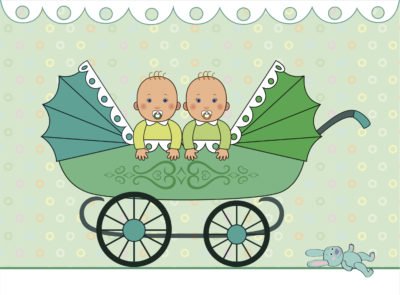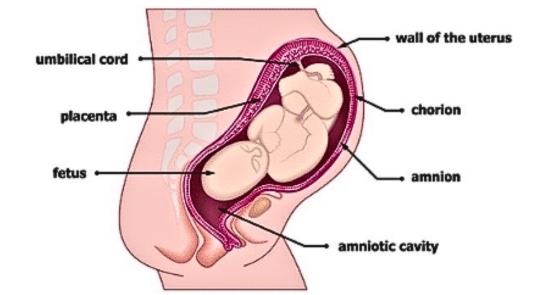There are Two Main Types of Twins: Fraternal Twins and Identical Twins. Get Wise(r) About Them Below…
Fraternal Twins

- Fraternal twins account for two-thirds of all twins.
- They’re created when 2 different eggs are fertilized by 2 different sperm. This means Mom-to-be releases 2 eggs during ovulation instead of the usual 1 egg.
- Fraternal twins can be hereditary if they run on Mom’s side of the family. (Dad’s side of the family doesn’t factor in here.)
Insider Info: If Mom is a fraternal twin herself, then she’s even more likely to give birth to fraternal twins.
- Each fraternal twin has their own placenta, chorion, and amniotic sac. We’ll discuss these terms in more detail below.
- From a genetic standpoint, fraternal twins are no more alike than any other siblings. They’re essentially siblings who happen to have the same birthday. As a result, fraternal twins can be the same sex (both boys or both girls) OR different sexes (1 girl and 1 boy).
Identical Twins

- Identical twins account for one-third of all twins.
- They’re created when a single fertilized egg splits and develops into 2 fetuses.
- This happens randomly, meaning there’s no hereditary component.
- Identical twins are 99.99% genetically identical and they’re always the same sex.
PediaTrivia:

There are 3 Different Types of Identical Twins. To Better Understand Them and Their Differences, Let’s Go Over a Few Anatomy Terms First.
- The Placenta: The placenta is an organ that develops during pregnancy and nourishes the baby.
- The Amniotic Sac: The amniotic sac is the “bubble” that surrounds the baby (or sometimes “babies”) in the uterus.
- The inner layer of the amniotic sac is called the amnion. It contains the baby and the amniotic fluid.
- The outer membrane is called the chorion. It contains the amnion (with the baby in it) plus a portion of the placenta.
Here’s a picture to help you visualize the 2 different layers of the placenta:

The 3 Subtypes of Identical Twins Differ in How Their Placentas, Amnions, and Chorions are Divided Up. Get Wise About How it All Breaks Down, Below:
1. “Diamniotic, Dichorionic Identical Twins”: In This Case, There are 2 Placentas + 2 Chorions + 2 Amnions.
- There’s not much sharing going on between diamniotic, dichorionic identical twins.
- Each twin has their own placenta, chorion, and amniotic sac. This is what we see with fraternal twins, too.
Double Take: Because fraternal twins have the same setup as diamniotic, dichorionic twins, it’s sometimes difficult to tell if twins of the same sex with 2 placentas, 2 chorions, and 2 amnions, are fraternal twins or diamniotic, dichorionic identical twins. If you can’t tell by looking at them, the doctor can do a DNA test after they’re born to find out.
2. “Diamniotic, Monochorionic Identical Twins”: In This Case, There’s 1 Placenta + 1 Chorion + 2 Amnions.
- Diamniotic, monochorionic twins share a placenta and a chorion, but each twin has their own personal amnion (“bubble”).
3. “Monoamniotic, Monochorionic Identical Twins”: This is the Rarest Type of Identical Twin and Includes 1 Placenta + 1 Chorion + 1 Amnion.
- In This Case, Sharing is Caring: Monoamniotic, monochorionic twins share everything — the placenta and the entire amniotic sac. This means the twins hang out in a common amnion, rather than in two separate bubbles.
Why Are You Telling Me All of This?
For 2 Reasons:
1. So you’ll be in the know if you’re expecting twins and your doctor starts throwing a bunch of confusing terms at you.
2. Because the more twins share, the riskier the pregnancy. This means that monoamniotic, monochorionic twin pregnancies carry the highest risk of all twin pregnancies.
What Risks are We Talking About?
The most worrisome complication that we see with monoamniotic, monochorionic twins is something called twin-twin transfusion syndrome. In twin-twin transfusion syndrome, the “donor” twin gives the “recipient twin” a bunch of blood. As a result, the donor twin becomes pale and anemic while the recipient twin develops a ruddy color from having too many red blood cells (fancy name: polycythemia). This isn’t a good look for either baby, so they both have to be delivered ASAP.
A Word About Triplets

Before the advent of IVF (in vitro fertilization), triplets seemed almost as rare as unicorn sightings. But this changed when IVF was introduced. Because of IVF, the birth rate of triplets and higher-order multiples (quadruplets, quintuplets, etc.) increased by 400% between 1980 and 1998.1 This rate is currently on the decline because doctors are being more judicious about how many embryos they transfer during IVF.
There are the 3 Ways Triplets Can Come Into Being. They Are:
- Option 1: 3 different sperm fertilize 3 separate eggs, yielding 3 fraternal siblings. This is the most common way triplets are created.
- Option 2: A single fertilized egg divides in two, creating identical twins. Not to be outdone, a second sperm fertilizes a second egg, creating a fraternal 3rd baby.
- Option 3: A single fertilized egg divides 3 ways, creating 3 identical babies. This is rare.
The Bottom Line
If you’re expecting twins, triplets, or higher-order multiples, you’ll be closely monitored throughout your pregnancy with extra doctor’s visits and ultrasounds. You may also be referred to a high-risk specialist, depending on how the pregnancy is going. These high-risk specialists really know their stuff, so you’ll be in good hands.








